|
Friday, February 2, 2007
Material has been obtained for tone panel mock-ups
to prove the new panel hanging method. These wenge boards have been planed
to thickness. Here are three 15cm wide quartersawn boars laid up together
as they will be glued. The relief profile will be cut at the backs of
the boards and the ligature hole drilled at each board before they are
joined.

A full-scale front elevation was drawn for
Stuart to approve the new shape and proportions.

++++++
Monday, February 12, 2007
The location of the fundamental nodes of the
tone panels is established at 256mm from the centerline. After researching
the several equations conceived to determine bar dimension and arch vs.
wood density as relates to pitch for the marimba (Fletcher and Rossing,
Murray and Greated, etc), I came to appreciate that the proportions of
the Heaven's Door tone panels exist outside of the influence of mathematics.
Marimba equations assume a certain relationship between length, width
and thickness. The Heaven's Door panels must be equal in width (2 panels
wide) and roughly equal in height (6 panels high) and of a thickness that
can be obtained in solid lumber of the desired specie (1" thick in
the case of wenge). The thought of laminating the tone wood was considered
and could be explored for future Doors, but the parenthetical improvement
in tone from this method must remain outside the scope of this project.
In my experiments, an adequate, if not exemplary, tone was achieved with
1" thick material using a simple trial and error method for determining
the best node location to enhance the fundamental tone. The panel was
placed on top of two moveable, insulated sticks laid on a graduated framework.
The reverberation of the fundamental tone was timed with a stopwatch when
struck. This node is where the hole for the cable will be placed, as shown
in these photos of boards awaiting to be joined into a panel and the template.


++++++
Monday, February 19, 2007
Construction of the super-frame has commenced.
Quarter-sawn white oak has been obtained for the framework. The following
photos show the process of assembling the bottom rail. the super-structure
frame is a lamination of three pieces of white oak, approximately 1"
in thickness. The ends are offset so as to make a dado-type joint with
the adjoining piece. Here we see that both ends of the bottom rail have
a central tenon that stand proud of the quartersawn face lamination by
the width of the vertical supports, which is 15cm. The edges of the rail
will be planed flush after the clamps come off. Each piece will be joined
with the next with glue and dowel pins



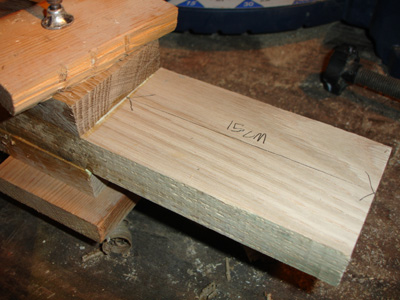

A finished tenon
++++++
Monday, February
19, 2007
Work on the super-frame
arch.
.JPG)
The various parts
are identified with a lettering system. A1 (shaded here) is the left side
front-facing lamination at the base of the arch. Its identical sisters
are A2, A3, and A4, A2 and A4 being the rear-facing laminations. B1 is
the central lamination at the left side base
.JPG)
Each piece is
allocated on the boards. The A and B laminations have the greatest arch
and require the widest boards. Here is a 10" wide oak plank for A1.
.JPG)
Here is the same board planed to thickness
and surfaced.
.JPG)
This is the poor man's CNC machine.
I have made full-scale templates in CADD which are glued to the face of
each board. The exact angle is noted and cut on the miter saw. . .
.JPG)
.JPG)
. . .then cut on the bandsaw.

Here is the finished A1 lamination.
The ruler and the line drawing beyond indicate the extent of the B1 lamination
that will be underneath and form the locking dado with the next 3-lamination
assembly of the segmented arch.
++++++
Thursday, March
8, 2007
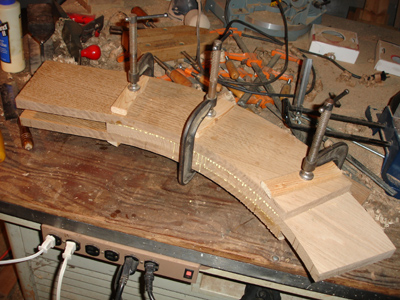
The first assembly of the arch is glued
up. This is A1, B1, and A2. Note quartersawn cuts for the A laminations
and flat sawn for the B core.
++++++
Sunday, March
11, 2007
.JPG)
One of the stiles is glued up.
.JPG)
A detail of the bottom of the stile
.JPG)
The arch components are cut
.JPG)
Two segments of the arch are glued up
but not yet glued together. Lamination E is at the apex of the arch.
.JPG)
Detail of the E-D-E lamination
.JPG)
The rail laminations are planed level
by hand before feeding into the planer
.JPG)
The arch laminations are made flat with
the scraper before final sanding with a palm sander
.JPG)
The framework is starting to rise.

The complete framework is laid out on
the floor for final fitting before gluing up. The paper has a full-scale
printout of the arch geometry from CADD to compare the work against the
drawing, making apparent any need for slight adjustment.
.JPG)
The cheeks of the tenon are scored before
gluing to ensure good glue penetration
.JPG)
The top of the arch is assembled. The
A/B and C/D assemblies on each side are joined at the apex with the E
lamination.
.JPG)
The stretcher rail for the bottom of
the frame is temporarily clamped at the bottom of the arch as a quick
method to ensure the proper distance is held.
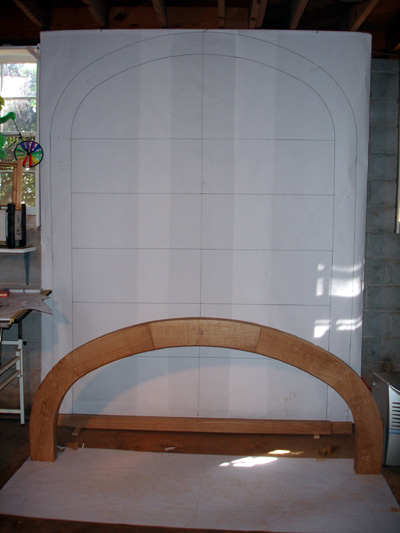
The arch is assembled.
++++++
Sunday, March
18, 2007
.jpg)
The arch is worked over with scraper
and beltsnader prior to assembly to the rails

.jpg)
The clamping pattern for ensuring the
arch and bottom rail snug completely to the stiles (side rails)
.jpg)
The frame is assembled. Work will now
commence on the individual door leaf frames.
++++++
Wednesday, March
27, 2007

The door leaf frame is laid out. The
"A" lamination of the arch still has its template paper on.
This is a dry fitting to check the mating of the parts. The door leaves
are constructed of two laminations rather than the three of the outer
frame. The addition of the tone panels will make the overall assembly
close to the thickness of the outer frame.
++++++
Monday, April
2, 2007
.JPG)
The same exercise as before with the
outer frame is performed for the door leaf frames: Each piece is assigned
a letter code. Full size templates for the arch segments are printed full-scale,
pasted to the wood and cut on the bandsaw. The straight pieces are planed
and chopped to length.
.JPG)
rails for the door leaves. Again, a
combination of flat and quartersawn pieces.
.JPG)
Rails glued up

Both door leaves in progress. There
will be a great amount of tension on the door leaves from the wire rope
assembly of the tone panels. The leaf framework will be further strengthened
by the uppermost curved tone panel which will be permanently affixed across
the top of the leaf, more in the manner of a soundboard rather than a
floating tone bar. This design will counteract door warping.
.JPG)
An in-progress leaf is resting in place
inside the outer frame.
++++++
Friday, April
6, 2007

The framework is on saw horses for the
final surfacing. The door leaves are near completion with the archwork
in progress.
++++++
Tuesday, April
11, 2007


The archwork for the door leaves is
glued up. The hinges have been purchased. There will be three Hager anti-friction
medium duty lift-off hinges per side.
++++++
Sunday, April
15, 2007

The outer frame gets a final working
over with the palm sander before the door leaves are attached


Holes are drilled for the tennon pegs


Tennon pegs are turned from the same
white oak of the frame.

One of the door leaves is hung
++++++
Sunday, April
22, 2007
.jpg)
The support brackets for the first Door
were metal and required through bolts which are visible from the audience
side. This is one of several subtle details I felt were too 'Machine Age'
for this project and I have endeavored to make the new Door rigid without
the use of steel. My bracket design strives for simplicity and minimal
exposure. Here is a strut and one of the two dadoed feet. There is a bracket
situated behind each of the two stiles of the outer frame, attached with
bolts to threaded inserts buried in the framework. There is no visible
support from the audience side. For the performance installation, full-height
curtains are hung on either side of the door to obscure the brackets,
as in the debut performance.
.jpg)
A general view of the mayhem. A half
basement is not large enough for this project and the gardening tools.
Here the brackets are installed and the finishing has begun on the door
leaves. The skeleton for the platform extends in place in front of the
door. I have created two large cavities for the resonation of the footwork
required for the performance. The platform of the first Door was merely
a hinged (for easy transport) piece of plywood. Mine has greater thickness
to coincide with the dimension of the bottom rail (absent in the first
Door) and has the bonus effect of creating these resonating cavities.
The platform will be covered with 2" wide strip tongue and groove
white oak flooring.
.jpg)
I hate this stuff. I am begrudgingly
filling the grain of the oak for a fine finish. This is a test area. I
quickly realized I should be tinting the filler because the final stain
is quite dark. This view also shows the bottom cleat of the door leaf.
It is screwed on rather than glued so it can be repositioned - or remade
as the case may be - to adjust the distance of the bottom anchoring points
away from the frame.
.jpg)

Goop in progress and the resulting product.
The piece will take at least two more coats of stain before it is dark
enough.
.jpg)
Some of the wonderful flake that turns
up in the quartersawn oak. This is the rear of a door leaf, which is a
combination of quarter and flat sawn. The face of the outer framework
is entirely quartersawn and shows the flake throughout. This will certainly
reinforce the 'old door' aesthetic Stockhausen conceived for the piece.
++++++
Sunday, April
29, 2007
.jpg)
The platform in progress. The decking
is standard 2 1/2" wide tongue and groove white oak strip flooring.
It will hold up better to the blows of the performance than plywood. However
it does make the platform very heavy - almost as heavy as the door frame.

.jpg)
A general view of the progress. The
frame and platform are stained but do not have a final finish (the spotlight
is casting on the platform). A clamp temporarily holds the platform tight
to the frame to prevent tipping forward. The platform will be attached
with two bolts from the rear of the door frame.
.jpg)
The swaging is complete. The "Ultra-Tec"
fittings have been permanently swaged to the 1/8" 7x19 wire rope
with 3/16" o.d. vinyl coating. This is also the platform.
++++++
Saturday, May
6, 2007
Progress begins on the tone panels.
The first Door had panels of six different varieties of wood, chosen by
Stockhausen for their various densities to produce different pitches.
The method for achieving pitch for the second Door is to cut relief dados
of various widths on the back of each panel, such as the method used in
marimba bars. This makes the use of different woods unnecessary, however
the second Door will have tone panels made of both wenge (used in the
first Door) and sapele (not used in the first Door). Stuart reported that
the wenge was the best sounding of the panels of the first Door, so we
attempted to make all the panels of our Door with this wood, despite its
liabilities of weight and cost. I was lucky to find quite a number of
quartersawn wenge boards here in Atlanta, but alas not enough for the
entire project. My suppler, who I have worked with for over 15 years,
suggested that finding more quartersawn wenge - from any location - in
the timeframe of the project was highly unlikely. Rather than compromise
and use a less-than-quartersawn cut, the decision was made to move to
another wood. Sapele was available quartersawn and has close to the density
of wenge. It was an acceptable substitution. The second Door will therefore
have six panels of wenge and six of sapele.
.jpg)
Two sapele boards being marked for the
hole placement. As previously determined, the first node is at 256mm from
the centerline. The board centerline is marked and the template is used
to autopunch a set hole
.jpg)
.jpg)
The set hole is circled. The brad point
bit is not tall enough to penetrate the board. . .
.jpg)
. . .so an extension bit is used off
the drill press to finish the hole. The extension bit will be used again
to clean out the hole after the panel is assembled. The 5/16" hole
allows easy passage for the smaller of the two swaged cable ends (just
over 1/4" diameter)
.jpg)
Rods the same diameter as the hole are
pushed through the holes for alignment during assembly.
.jpg)
Two sapele boards laid up. Each panel
is between 3-4 boards tall.
.jpg)
After the clamps come off, the seam
is planed with the scraper. . .

. . .and fed through the drum sander.
This is a wenge tone panel
.jpg)
The first panel is set in place with
the wire system. a stick with holes in the appropriate place for the tensioners
is temporarily clamped in place. Small rubber washers are set between
the bottom of the panel and bottom rail. The tolerance between the panel
and the framework is tight, due to the fact that the upper panel is the
source of the wires. To keep the panels off of the framework when struck
I have inserted two thin oak sticks behind the panel at the node. The
dampening affect is negligible.
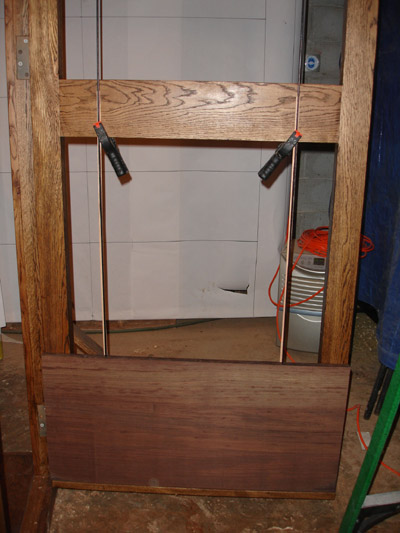
A detail of the assembly
++++++

The newspaper shot
++++++
Wednesday, May
9, 2007
.JPG)
A tone panel having the relief cut into
the back. A 2" wide by 1/8" deep channel reduces the fundamental
by a semitone compared to an unrouted panel. Widening the channel in 3/4"
increments reduces the pitch an additional semitone.
.JPG)
The cremone bolt set has arrived. The
rods slide on the attached tabs. Decorative covers for the tabs are in
the bags. A doorknob is inserted into the box. I'll be trolling the antique
stores for that.
.JPG) \ \
Progress on the tone panels. The spandrels
(upper curved panels) are in place, two wenge panels are in their correct
places on the left. On the right a sapele panel that occurs higher in
the order is for now sitting on the bottom. I am experimenting with different
stick lengths behind the panels to hold the panels off the frame at the
node. At this point the decision was made not to permanently affix the
spandrels to the frame in a "soundboard method". To preserve
the ability to change out ALL the panels in the future, a new method is
needed to hold the panels in place. Removable bolts located at the node
location is sufficient to resist the wire rope tension. I believe the
framework is stout enough to not require the extra stiffening of a permanently
affixed spandrel.
.JPG)
.JPG)
Details of the progress

Detail at the back of a spandrel showing
the routed pockets for the tensioners. The swaged wire rope is threaded
up through the bottom of the spandrel into the tensioning sleeve which
is just barely visible at the bottom of the pocket. A hex allen wrench
turns the sleeve and tightens the rope. Two bolts tapped at the fundamental
hold the panel to the frame. The bolt is tapped into a threaded insert
in the panel to make repeated disassembly possible.

The lowest panel of the right hand
leaf is tuned against the left hand leaf.
++++++
Sunday, May 20,
2007
.JPG)
The first leaf is hung with all its
panels.
.JPG)
The right-hand spandrel panel is being
tuned. Because of its asymmetrical shape, this panel's relief must be
routed differently from the others. I am experimenting with removing material
to balance the mass along an off-center and skewed centerline
.JPG)
The spandrel panels are held by two
bolts, on the node centerline, at the top edge. No further support at
the bottom is required, however to keep the panel from touching the framework
I have set a stick into the frame along the bottom edge and placed two
felt pads, again at the node, to insulate the panel. Note also the asymmetrical
routing of the back. This is the final week of work on the Door. The instrument
will be transported to Stuart's studio at the end of this week.
++++++
Tuesday, May
22, 2007
.jpg)
The panel hanging system: The upper
panel is in place, held off the frame by its bolts and the stick. The
wires are threaded up into the upper panel and the second panel is in
place. The rubber washers are in place on the wire to separate the panels
and the third panel is being slid into place. . .
.jpg)
. . .now all the panels are in place.
The bottom washers are on and the bottom rail is ready to be attached.
. .
.jpg)
. . .bottom rail now in place with the
washers and lock washers in place. Now the bottom rail is screwed on in
seven staggered locations. The discoloration on the rail is the result
of the piece being dragged on the floor to get it in place. This will
not be seen once the door is assembled.
.jpg)
Both leaves are hung. The panels do
not yet align properly because the right-hand leaf is not tensioned. Note
outward buckling of the panels on the right edge. The left-hand leaf does
not have its panels in the proper sequence. The sapele panels will be
stained darker to match the wenge. The desire is to obscure the panel
edges so the audience perceives a continuous plane over which different
sounds are obtained, heightening a mystery to the door. This idea contributed
to the deletion of the routed edges, originally planned for the panels.
The routed edges also would hinder the glissandi required for the piece.
.jpg)
This rear shot shows the differences
in the panel routing. Stuart and I have designed a pitch range for the
instrument of about an octave and a third, with care not to make any of
the intervals a true step or half-step and indeed no combinations of pitches
to be a perfect third, fifth, octave, etc.
++++++
Thursday, May
24, 2007

The panels are tuned and in their proper
sequence. The sapele panels must now be stained.

The drawing has been updated with hardware
tags and the revisions made to the design including the spandrel hanging
method and the support bracket and platform change.
++++++
Friday, May 25,
2007

The sapele panels are stained. The gloss
is temporary from being wet. They will dull to the level of the unfinished
wenge panels
.JPG)
There's an old woodworking saying: you
can take wood away but you can't put it back. This is the right-hand spandrel
that is currently pitched( (incorrectly) lower than the left-hand panel.
It was the first of the two spandrels to be routed and I wound up taking
too much material away in an attempt to get the panel to resonate properly.
Rather than scrap the panel and make a new one, or worse, repitch the
other spandrel and consequentially the other 10 panels lower to compensate,
I am scabbing on pieces of wood to the routed areas and removing material
at the outer edges in an attempt to raise the pitch. I have also discovered
that the panels change their pitch, seemingly arbitrarily, after the routing.
(!!!) Having sequentially pitched the panels the first time, I found that
after a couple of days of setting that the pitches moved and the panels
we no longer sequenced properly. This was disturbing at first, and I don't
have an explanation, but thankfully the problem did not represent itself
when I made a second pass at them. (I have stamped numerals into the edge
of each panel to avoid mistaking one for the other) So I have now pitched
all the panels twice. The panels will be hung for the second time in Stuart's
studio and we shall see if the wood has truly stabilized at a pitch and
if indeed they meet the intervals required by the piece. We are not necessarily
matching pitches called for by Stockhausen, but Stuart, having a feel
for what the pitches should be for a successful interpretation of the
piece, is guiding the work.
.JPG)
This is a rather inauspicious last image
for this series, but it is the last night of work, and this is what it
looks like in the workshop. The platform is turned up on end to resecure
one of the t-nuts that holds the platform to the frame. The outer frame
is resting against a floor joist, and along with the brackets, resting
on the table in the foreground, has received a top coat of tung oil. The
door leaves rest against the table in the foreground and the troublesome
spandrel in on horses in the middle with its coat of stain. The other
panels are leaning against the far wall. The whole lot is headed out the
door tomorrow to Stuart's studio at GSU.
++++++
Tuesday, May
29, 2007

To build you must destroy. It is the
cycle of life. This is the ceremonial demolition of the basement door
to facilitate the removal of the project. Our basement door is 6'-8"
tall but fortunately the builder put a transom window over it, later removed
and covered over with vinyl siding. We're putting the window back after
the project is over.
.jpg)
The door is delivered to a Georgia State
rehearsal studio

.JPG)
.JPG)
Some process images of installing the
panels
.JPG)
A good closeup shot of a "clip-on"
fitting at the bottom cleat.
.JPG)
Complete installation. Next stop, Charleston.
++++++
Monday, June
4, 2007
Images from the Spoleto weekend. . .


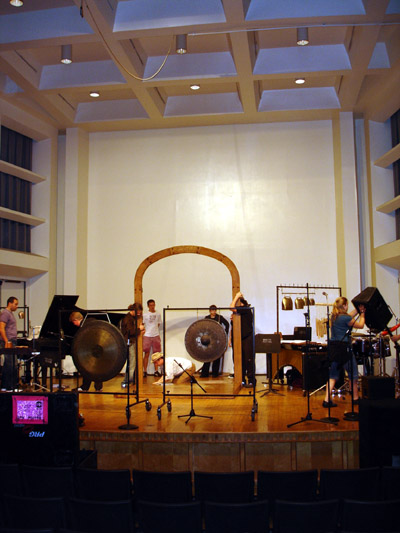
The setup, showing also the instruments
required for Kontakte

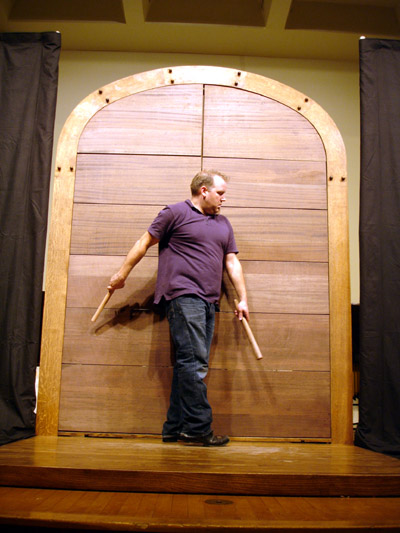

Stuart rehearsing the piece.


I took one discrete photo during the performance,
without a flash of course, that actually came out pretty good: capturing
the moment when the child passes through.
++++++
Thursday, November
1, 2007


The door is back in the workshop for some
rework. After the Charleston performance it was clear that the bulk of
the outer frame would make future performances difficult. Stuart has asked
me to make the outer frame disassemble as the first door. Wanting to avoid
the metal straps of the first door and keep with the timber-frame aesthetic
of my design, I have made pinned mortise and tennon joints.

I am also taking the opportunity to redo
the method of attachment of the braces, removing the threaded bolt inserts
and adding a dovetailed cleat that the brackets will slide on to attach.
This rework will also include a new method
for attaching the upper panels to the door leaf framework as the resonance
of these upper panels was subdued in comparison to the others. The experimental
nature of the project can not be overstated.
++++++
Sunday, January
20, 2008

The pins to secure the arch are in place.
The pins are slightly undersized for the hole and provided with string
pulls to alleviate sticking.

Showing the new bolt location (old location
to the right) where the platform is held to the superstructure. The bolt
is received by a permanently fixed heavy-duty threaded plate at the back
rail of the platform. Because of the weight of the platform the two rigidly
fixed bolt points, movement within the frame when assembled is all but
eliminated. The rear facing braces, now sliding on dovetailed cleats after
the bolts are inserted, check movement when the doors open.



A series of shots showing the threading
of nylon rope through the panels. Following the Charleston performance
it became clear that the wire rope system was an over-engineered solution
and because the top of the tensioning was occurring in the midst of -
instead of at the top of - the spandrel panel that the tension was hindering
vibration. By using a nylon rope we are eliminating a proprietary hardware
(swaged wire rope with specialized fittings) for a more readily available
material and at the same time having the point of security at the very
top edge of the panel. The new rope will be tensioned (I anticipate) by
using a wood key (slat) to make torsion between the loose rope ends that
pass by one another on the back of the framework.
++++++
Tuesday, April
22, 2008

The spandral has been sliced so that the
upermost portion that contains most of the arch is now the fixed (it is
glued to the frame) anchorage and the lower portion of the spandral is
free-vibrating. it has a piece of the next lower plate scabbed to it to
make a larger rectaliniar area of vibration.


Details showing the new anchorage system.
The vertical nodal sticks are in place and allow tie-backs to happen to
keep the plates from buckling outward. The tensioned rope is attached
at both ends to the single peg. This is a more complicated system than
used for the Charleston performance, but it is more intuitive - shedding
the proprietary hardware and need for wire rope swaging. It also puts
less stress on the framework. Its main advantage is, of course, that it
is allowing all the plates to vibrate to the same degree. Also, in the
foreground of the long shot, is is the outer framework showing the middle
hinge removed and wood being scabbed into the mortise. I have determined
the center hinge is not required structurally and the leaves are easier
to install without them.
betsillworkshop
|
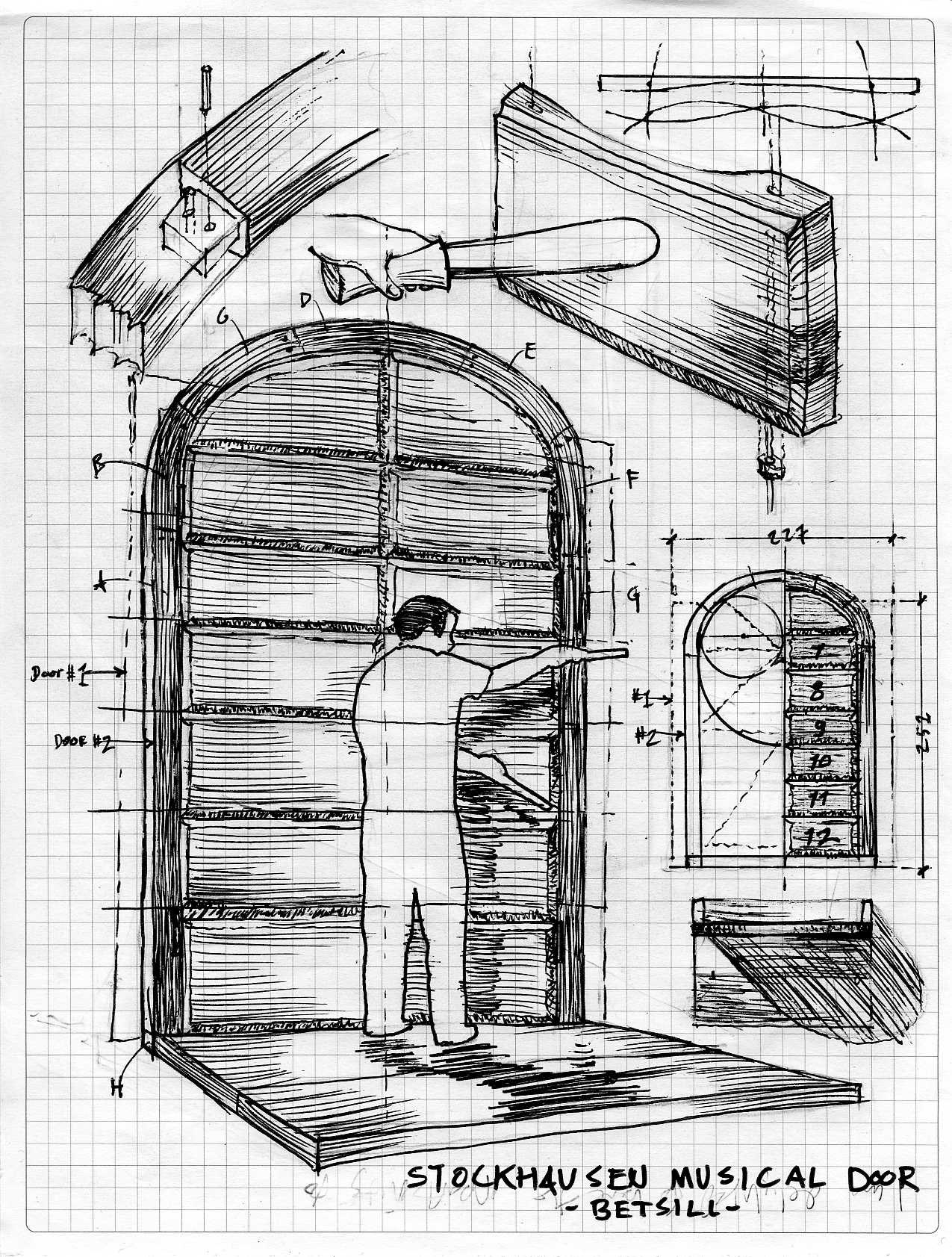

















.jpg)

.jpg)
.jpg)
.JPG)
.JPG)
.JPG)

.JPG)








.jpg)
.jpg)
.jpg)
.jpg)

.jpg)
.jpg)

.jpg)
.jpg)
.jpg)
.jpg)
.jpg)
.jpg)
.jpg)
.jpg)
.jpg)

.jpg)




.JPG)
.JPG)
.JPG)
.jpg)
.jpg)
.jpg)
.jpg)
.jpg)




.jpg)

.JPG)
.JPG)
.JPG)
.JPG)












